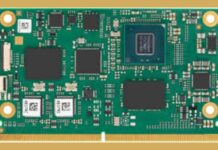Munich, Germany – The global trend to gradually eliminate the use of fossil fuels has challenging consequences for numerous industries, including transportation. The transition toward green mobility, for example, entails a reduction in short-haul flights and travel by car, which in turn will encourage the growth of rail transportation. Government decarbonization measures support this development: In Europe, various subsidy programs worth billions of euros are planned for rail transportation. Changes are on the horizon in this industry, as diesel locomotives and railcars will be incrementally replaced by environmentally-friendly, electric solutions.
Considering the coming requirements of green mobility, new technologies must be developed, with increased energy efficiency in particular being a key objective. To support this trend, Infineon Technologies will launch power semiconductors with CoolSiC MOSFET and .XT technology in the XHP 2 package – tailored specifically to the requirements of rail services.
Semiconductor solutions for quieter streetcars
The XHP 2 power module from Infineon has already proven its worth in a joint field test conducted by Siemens Mobility and Stadtwerke München (SWM). An Avenio streetcar in Munich was equipped with these power modules and tested in passenger service for a year, covering around 65,000 km. Siemens Mobility concluded that this use of power semiconductors based on silicon carbide (SiC) had made it possible to reduce the energy consumption of streetcars by ten percent. At the same time, it was also possible to significantly reduce engine noise during operation.
“Innovative semiconductor solutions for rail technology are an important driver for green mobility. The successful field test with streetcars in Munich demonstrates the benefits of SiC technology for manufacturers, rail operators, and residents,” said Dr. Peter Wawer, President of Infineon’s Industrial Power Control Division. The tests were carried out under the European development and research project PINTA and are part of the extensive European research and innovation initiative Shift2Rail[1], which aims to create a sustainable European rail system through targeted investments.
Higher energy efficiency thanks to silicon carbide
Implementing SiC in power modules for traction propulsion systems can also pose major challenges: In addition to an efficient and very robust SiC chip, packages that allow high switching speeds are required, as well as interconnection technologies that enable a long service life. These are precisely the features offered by Infineon’s power module: Since trains accelerate and decelerate frequently, the power cycles for semiconductors in rail applications are very demanding. The constant temperature fluctuations stress the interconnection technology. Infineon’s .XT technology provides a solution to this challenge. The technology significantly improves the lifetime during power cycles and has been used successfully for years in similarly challenging applications such as wind turbines.
In Infineon’s XHP 2 power module, CoolSiC MOSFET chips enable low conversion losses while maintaining high reliability. They are the basis for increased energy efficiency and are already used today in many applications like photovoltaic systems. Infineon’s XHP 2 package features low stray inductance, a symmetrical and scalable design, and high current capacity. As a result, the package is ideally suited for SiC.
Thus, in addition to the established application areas of photovoltaics and charging infrastructure for electric vehicles, silicon carbide MOSFETs now also provide significantly more energy efficiency in the area of rail-bound vehicles.
Infineon will host the “Industrial Wide-Bandgap Developer Forum” for design and development engineers as a livestream on March 31, 2022. During the event, Stefan Schönewolf from Siemens Mobility GmbH will talk about SiC in rail vehicles. Those interested can register for the event free of charge here.
More information about Infineon’s contribution to energy efficiency: www.infineon.com/green-energy
[1] This project has received funding from the Shift2Rail Joint Undertaking (JU) under grant agreement No. 826054. The JU receives support from the European Union’s Horizon 2020 research and innovation program and the Shift2Rail JU members other than the Union.


















